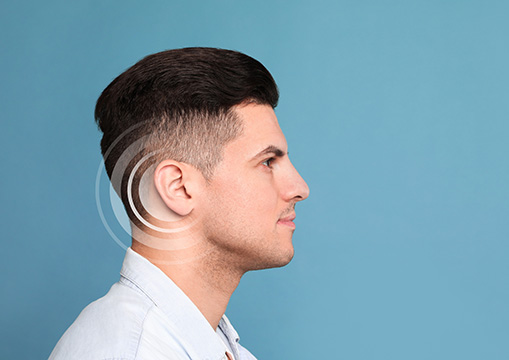A Complete Guide to the Different Types Of Hearing Loss
The human ear is the key organ of one of the five senses – hearing. It allows us to hear, a crucial part of our daily lives, right? Well, while that might sound obvious, oftentimes, we don’t realize how important it is before suffering from the absence of it.
Hearing loss doesn’t mean it has to be a complete loss. You might find it hard to hear your friend or find most sounds muffled. This can happen for a lot of reasons. Old age might cause the nerves in your ear to decay and cause a natural hearing loss. Or you might have damaged your hearing from working in a loud environment.
Either way, you must understand the different types of hearing loss to properly identify the symptoms and see how serious the issue is.
Let’s jump right in:
Type #1: Conducive Hearing Loss
When the sounds can’t reach the eardrums and bones of the inner ear from the outer ear, it’s called conductive hearing loss. Earwax and other fluids are responsible for clogging the ear canal – this happens because of illness or allergies. Other potential causes include an infected ear or a punctured eardrum.
Conduction hearing loss typically only affects the “volume” of sounds, as opposed to other types of hearing loss that make it difficult to hear and understand sounds. Loud sounds might not seem as loud, while faint sounds might be considerably harder to hear.
Sometimes you can cure conductive hearing loss by simply cleaning out the excess wax or liquid from the ear canal. In other circumstances, surgically implanted implants or hearing aids can help transmit sound waves to the inner ear and help you recover as much of your hearing as possible.
Though it isn’t always preventive, the best deterrent against conductive hearing loss is to take proper care of your ears. Avoid cleaning them with cotton swabs because doing so could harm the eardrum and push earwax inside. Having said that, a small amount of earwax is beneficial because it protects the inner ear from contaminants like dust. Additionally, you should keep your ears dry and shield them from loud noises.
Type #2: Sensorineural Hearing Loss
This happens if you have problems in the cochlea – the nerves from the inner ear to the brain – which convert sound into signals that are conveyed to the brain. 90% of people with hearing loss have this. When the nerves lose their ability to function due to various factors, including aging, disease, exposure to noise, heredity, and head trauma. The worst part, there’s no way to cure it.
People with sensorineural hearing loss face difficulty understanding speech. They can’t properly judge volume and clarity. They feel as if most people are mumbling and sounds appear muted.
Sensorineural hearing loss can’t be cured; however, you can treat it by implanting hearing aids. You can increase the sound around you with them. This allows the user to hear sounds louder than they are.
Hearing aids are known to be able to help 95% of all hearing impairments.
People with severe hearing loss can get cochlear implants – which deliver electrical stimulation directly to the auditory nerve – a great option for people who find hearing aids as insufficient.
There is no way to prevent this other than protecting yourself from noise.
Type #3: Mixed Hearing Loss
Mixed hearing loss is when someone has symptoms of both sensorineural and conductive hearing loss. This might occur if the cochlea or auditory nerve in your inner ear is damaged, plus the outer or middle ear is blocked or damaged. A mixture of elements that cause both conductive hearing loss and sensorineural hearing loss results in mixed hearing loss.
Since they are easily curable, ear specialists frequently feel it advantageous to treat the conductive issues first. They will then be able to more accurately determine the severity of your sensorineural hearing loss and give you aids.
If you suspect you may have hearing loss, the best approach is to have your hearing evaluated by a specialist as quickly as possible. Leaving hearing loss unchecked is not a smart choice because it has been related to various health issues and strains your relationships and daily life.
Everyone should undergo an annual hearing check, even if they aren’t currently showing symptoms. Annual screenings provide you the opportunity to keep an eye on your hearing condition and act as soon as any conditions develop, much like with a routine doctor’s visit.
You Have Hearing Loss, What Now?
Aside from natural reasons like aging or by birth, you can also have hearing problems for reasons like noise pollution and accidents. You have hearing loss, what now?
Well, many solutions will allow you to recover most of your hearing capabilities. A few of the popular solutions are–
Hearing aids: Hearing aids amplify the sound of your surroundings, allowing you to hear sounds that would appear muffled to you otherwise. A specialist will assign you one based on the severity of your hearing issue. These can be very sophisticated and include extra features like noise cancellation as well. There are many options like –
- Behind the ear (BTE)
- In the ear (ITE)
- In the canal (ITC)
- Completely in canal (CIC)
- Invisible in canal (IIC)
Cochlear implants: An electronic device that sends electronic signals through the nerves in your cochlea to allow you to hear the sounds properly. This is used in severe cases where people are nearly deaf.
The doctor will give you an option suited to your lifestyle. Although there are cures for hearing loss, taking care of your hearing is still crucial.
To Wrap It Up
Hearing loss doesn’t mean the end of regular life as you know it, because of the advancements in medical science, you can heal your hearing loss to the degree that won’t hamper your daily life.
However, prevention is better than a cure, that’s why – don’t miss out on your yearly ear checkups and, treat your ears with care, try to avoid noisy places that can damage your hearing in the first place.
Glue ear, after draining the ear drum
Glue ear, intact ear drum
- About the Author
- Latest Posts
Dr Ronald Chin is an Australian trained Otolaryngologist Head and Neck Surgeon.
After graduating as a Fellow of the Royal Australasian College of Surgeons, Dr Chin undertook further specialised training in Head and Neck Cancer at the Royal College of Surgeons in Ireland.
He has published many research papers and is an active teacher and scholar.
As part of his subspecialty training, Dr Chin has training in Laser, Da Vinci Robotic, Flex Robotic and complex surgical techniques.
In addition to specialised Head and Neck Cancer, Dr Chin also enjoys general adult and paediatric ENT Surgery and practices sinus, snoring/sleep and general paediatric ENT Surgical procedures.
Dr Ronald Chin works as a general Otolaryngologist, offering a wide range of surgical and non-surgical treatments including ear surgery, nose surgery and throat surgery. He provides treatment for chronic conditions such as tonsillitis, sinus problems and problems with hearing.
He is also involved in the diagnosis and treatment of many conditions such as facial paralysis, head and neck cancer and sleep apnea. As well as performing surgery on children, he also provides specialist care for adults, including the treatment of throat disorders, voice loss and ear problems.
Dr Chin has also served as a Conjoint Associate Professor at the University of Sydney, a Conjoint Associate Professor at Western Sydney University and an Adjunct Associate Professor at the University of Technology Sydney.








